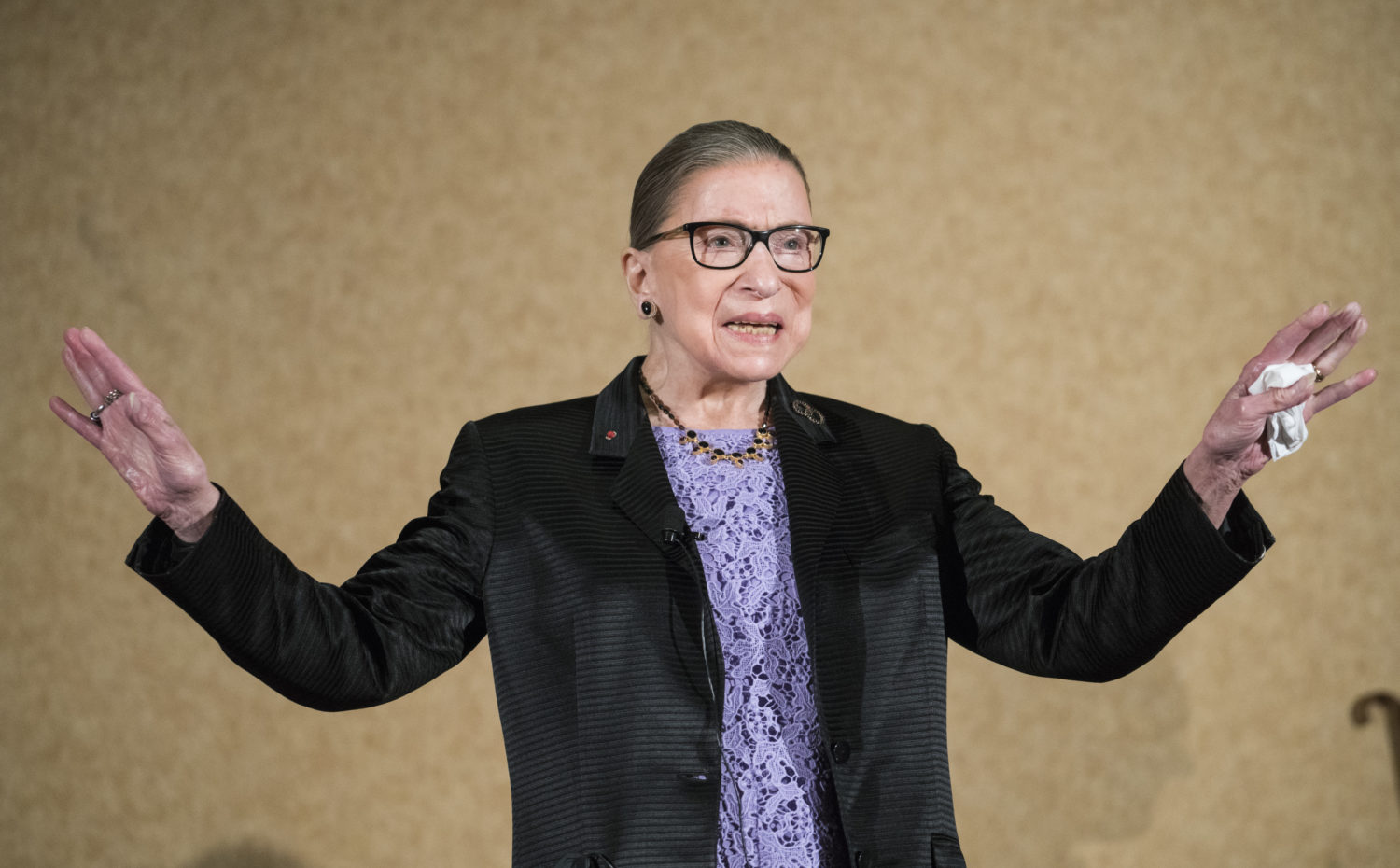This story has been updated.
The 2020 election just inherited a new issue.
Justice Ruth Bader Ginsburg, who died Friday at the age of 87, told her granddaughter, “My most fervent wish is that I will not be replaced until a new president is installed.” But that wish may not be fulfilled. In fact, President Donald Trump will have the opportunity to place three U.S. Supreme Court justices on the bench in four years.
Senate Majority Leader Mitch McConnell wasted no time Friday night announcing that a confirmation vote for Ginsburg’s successor would happen this year. Even if Trump lost re-election and even if the Senate lost its GOP majority, Republicans have an opportunity to fast-track a confirmation. Democratic presidential candidate Joe Biden said Friday night that no confirmation should happen until the election is settled. It is not impossible, but is considered unlikely, that the Senate would attempt a confirmation before Election Day.
U.S. senators are sworn into office Jan. 3 and the presidential inauguration is Jan. 20. If the Republicans lose control of the Senate, they would have until Jan. 3 to hold confirmation hearings, debate and vote. Typically, confirmation takes months, but McConnell has already expressed determination to make this process move quickly.
There are 53 Republican U.S. Senators. It takes 51 votes to confirm a Supreme Court justice.
Friday night, just before word of Ginsburg’s death, Alaska Sen. Lisa Murkowski (R) said in an interview that if she was presented with a vacancy on the court, she would not vote to confirm a nominee before the election. But she did not address whether she would vote in a lame-duck session between the election and a new Senate being sworn in.
Similarly, Republican Sen. Susan Collins of Maine told The New York Times recently that she would not seat a new justice before Election Day, but that does not address whether she would confirm a justice after Election Day and before a new Senate is sworn into office.
Another unknown is how moderate retiring Republican Sen. Lamar Alexander might vote on whether to confirm a nominee. Senator Charles E. Grassley of Iowa said in 2018 that if there was a vacancy in 2020, he would not favor bringing a nominee to the Judiciary Committee for confirmation. Sen. Mitt Romney of Utah has shown a willingness to break from Trump’s will and could resist a GOP push for confirmation in 2020. It would take four Republican senators to vote “no” since Vice President Mike Pence breaks tie votes in the Senate.
There is one other complexity that could change the math. Republican Sen. Martha McSally of Arizona is in a battle to keep the seat she was appointed to fill after Republican Sen. John McCain died. Her opponent is former astronaut Mark Kelly, a Democrat who is currently leading in polls. The election is technically a special election, which means the winner would be sworn in as early as the end of November. If Kelly won, the GOP leadership would have to act even faster to get confirmation of a GOP-nominated justice.
If Trump wins re-election and if the Senate maintained a Republican majority, then there would not be pressure to rush a confirmation. McConnell opposed a vote on Barack Obama’s nominee because it was an election year — he said the voters should decide who nominates a new justice. But McConnell said outright that if he had an opportunity to confirm a justice in 2020, he would do so. Republicans hold a Senate majority and the presidency, he noted, saying that is what makes this circumstance different from 2016.
It is not an unimaginable scenario that in the weeks after the November election we could still be counting votes, and maybe even have a legal battle before the Supreme Court while the Senate attempts to push through a confirmation.
At the same time — indeed, in the same week after the election — the court is scheduled to hear a legal challenge to the Affordable Care Act. The last time the Supreme Court considered the constitutionality of Obamacare, it affirmed it 5 to 4. This time, without Ginsburg, the outcome will be much less certain.
Possible nominees
Last week, Trump released a list of people that he said would be the top of his list to take any vacant Supreme Court seat. The list surprised everyone, including some of the people on the list. It included seven federal appeals court justices and two U.S. senators. The list includes:
- Bridget Bade, a judge on the United States Court of Appeals for the Ninth Circuit.
- Daniel Cameron, the Kentucky Attorney General and former legal counsel to McConnell.
- Tom Cotton, U.S. senator from Arkansas who said after Trump named him that if he was ever placed on the Supreme Court he would seek to overturn Roe v. Wade.
- Paul Clement, an attorney who previously served as Solicitor General of the United States and has argued over 100 cases before the Supreme Court.
- Ted Cruz, a U.S. Senator from Texas who has alternated between staunch Trump foe to occasional ally.
- Stuart Kyle Duncan, judge on the U.S. Court of Appeals for the Fifth Circuit.
- Steven Engel, Assistant Attorney General for the Office of Legal Counsel of the United States Department of Justice.
- Noel Francisco, the former Solicitor General of the United States.
- Josh Hawley, U.S. senator for the state of Missouri. Hawley tweeted that he has “no interest in the high court” and will “look forward to confirming constitutional conservatives” as a member of the senate.
- James Ho, judge on the U.S. Court of Appeals for the Fifth Circuit.
- Gregory Katsas, judge on the U.S. Court of Appeals for the District of Columbia Circuit.
- Barbara Lagoa, judge on the U.S. Court of Appeals for the Eleventh Circuit.
- Christopher Landau, U.S. ambassador to Mexico.
- Carlos Muñiz, justice on the Supreme Court of Florida.
- Martha Pacold, judge on the U.S. District Court for the Northern District of Illinois.
- Peter Phipps, judge on the U.S. Court of Appeals for the Third Circuit.
- Sarah Pitlyk, judge on the U.S. District Court for the Eastern District of Missouri.
- Allison Jones Rushing, judge on the U.S. Court of Appeals for the Fourth Circuit.
- Kate Todd, deputy assistant to the president and deputy counsel to the president.
- Lawrence VanDyke, judge on the U.S. Court of Appeals for the Ninth Circuit.
Axios reported there are other names on the list that might even include the top pick. “Judge Amy Coney Barrett, who has long been viewed in Trumpworld as next in line to fill a vacancy on the bench, is still at the top of the list after her inclusion on Trump’s original list, along with Judge Amul Thapar and Sen. Mike Lee (R-Utah).”
FAQ about the confirmation process
The Supreme Court website has an extensive page of questions and answers about the confirmation process.
Once the president presents a nominee’s name, the matter goes to the U.S. Senate Judiciary Committee. The chair of that committee is Sen. Linsey Graham, who is in a pitched re-election battle in South Carolina.
Has anyone ever been confirmed to the court in a lame-duck session between Election Day and Inauguration Day?
The short answer is yes. Congressional Quarterly tells the story:
Clearly, the most important lame-duck nomination ever was John Adams’ appointment of the great chief justice John Marshall in January 1801 with Adams’ partisan opponent, Thomas Jefferson, two months from taking office. In 34 years on the bench, Marshall set the Supreme Court on a Federalist interpretation of the powers of the national government that survived mostly intact even after the states rights-minded Roger B. Taney succeeded him for the next 28 years. Andrew Jackson appointed Taney in December 1835; Taney won Senate confirmation in March 1836, as Jackson began the fourth year of his first presidential term.
Lincoln appointed his secretary of the treasury, Salmon P. Chase, as Taney’s successor in December 1864, after the November election but before his formal re-election by the Electoral College in January 1865.
What are the qualifications to be a justice?
The U.S. Constitution does not list many requirements for a justice. It does not require a law degree, it does not require a person to have been born in the United States and it does not specify an age or even require a college degree. Not surprisingly, every justice has studied the law, but in the 1700s and 1800s, many justices did not attend a law school but instead studied under a mentor, which was the norm of the day. The Supreme Court website points to two justices who had unusual backgrounds:
- The last justice to be appointed who did not attend any law school was James F. Byrnes (1941-1942). He did not graduate from high school and taught himself law, passing the bar at the age of 23.
- Robert H. Jackson (1941-1954). While Jackson did not attend an undergraduate college, he did study at Albany Law School in New York. At the time of his graduation, Jackson was only 20 years old and one of the requirements for a law degree was that students must be 21. Thus, rather than a law degree, Jackson was awarded a “diploma of graduation.” Twenty-nine years later, Albany Law School belatedly presented Jackson with a law degree noting his original graduating class of 1912.
Do we have to have nine justices? Could there be more?
While we are considering all the possibilities ahead, here is one that is not commonly discussed: There is no constitutional requirement on how many justices serve on the Supreme Court. That is up to Congress and Congress has changed its mind over the centuries. Let’s start with the Constitution:
Article III, Section 1, starts with a broad direction to Congress to establish courts. “The judicial Power of the United States, shall be vested in one supreme Court, and in such inferior Courts as the Congress may from time to time ordain and establish.”
The first Judiciary Act, passed in 1789, set the number of justices at six: one chief justice and five associates. But it changed a lot since then. In fact, once we had 10 Justices.
The Constitution Center points out:
Since 1789, Congress changed the maximum number of Justices on the Court several times. In 1801, President John Adams and a lame-duck Federalist Congress passed the Judiciary Act of 1801, which reduced the Court to five Justices in an attempt to limit incoming President Thomas Jefferson’s appointments to the high bench. Jefferson and his Republicans soon repealed that act, putting the Court back to six Justices. And in 1807, Jefferson and Congress added a seventh Justice when it added a seventh federal court circuit.
In early 1837, President Andrew Jackson was able to add two additional Justices after Congress again expanded the number of federal circuit court districts. Under different circumstances, Congress created a 10th circuit in 1863 during the Civil War, and it briefly had a 10th Supreme Court Justice. However, Congress after the war passed legislation in 1866 to reduce the Court to seven Justices. That only lasted until 1869, when a new Judiciary Act sponsored by Senator Lyman Trumbull set the number back to nine Justices.
FDR tried to add a couple of justices who agreed with his policies, but failed. Since then, we have stuck with nine justices.
Imagine that Republicans lost the Senate and lost the presidency but in the weeks after the election jammed through a confirmation of a conservative justice. It would be at least theoretically possible that a Democrat-collected House, Senate and president could add more justices to the court and reset the political balance.
Al Tompkins is senior faculty at Poynter. He can be reached at atompkins@poynter.org or on Twitter, @atompkins.








You claim to be unbiased but look at the language used in this article.
– Senate Majority Leader Mitch McConnell “wasted no time” Friday night announcing that a confirmation vote for Ginsburg’s successor would happen this year.
– Imagine that Republicans lost the Senate and lost the presidency but in the weeks after the election “jammed” through a confirmation of a conservative justice.
(Jammed is such an unbiased word.)
Has a president been in this same situation before? Yes, 29 times. 29! And yes, lame duck presidents, not the case this year, have appointed justices.
When the House is the same party as the president, typically the justice is approved. When the House is a different party, the justice is typically not approved.
Check out a quote from President Obama where he states that it is the president’s responsibility to appoint a justice if an opening happens.
Thank you so much for your “unbiased” reporting.
I appreciate Cynthia’s thoughtful and critical note. She is right. I should not have used “jammed.” I would say “wasted no time” is defensible and/but was unnecessary. I would in retrospect edited out the phrase as it is unneeded. I should have just said he announced it hours after the Justice’s death and left it there.
We do take these things seriously and it is great when a reader pays close enough attention hold our feet to the fire.
Al